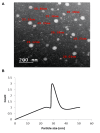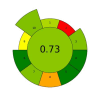Innovative anti-proliferative effect of the antiviral favipiravir against MCF-7 breast cancer cells using green nanoemulsion and eco-friendly assessment tools
- PMID: 39537766
- PMCID: PMC11561084
- DOI: 10.1038/s41598-024-78422-2
Innovative anti-proliferative effect of the antiviral favipiravir against MCF-7 breast cancer cells using green nanoemulsion and eco-friendly assessment tools
Abstract
Telomerase enzyme prevents telomere shortening during division, having human telomerase reverse transcriptase (hTERT) as its catalytic subunit. Favipiravir (FAV), an RNA-dependent RNA polymerases inhibitor, shared structural similarity with hTERT and thus assumed to have cytotoxic effect on cancer cells, in addition to its prophylactic effect to immunocompromised cancer patients. Nanoemulsion (NE) is a potential tumor cells targeting delivery system, thereby enhancing therapeutic efficacy at the intended site, mitigating systemic toxicity, and overcoming multidrug resistance. The objective of this study is to develop a green FAV nanoemulsion (FNE) that is environmentally friendly and safe for patients, while aiming to enhance its cytotoxic effects. The study also highlights the environmental sustainability of the developed RP-HPLC method and assesses its greenness impact. The FNE formulation underwent thermodynamic stability testing and invitro characterization. Greenness was assessed using advanced selected tools like the Analytical Eco-Scale (AES), Analytical Greenness Metric for Sample Preparation (AGREEprep), and green analytical procedure index (GAPI). The cytotoxic potential of FNE was screened against MCF-7 breast cancer and Vero normal cell lines using SRB assay. Stable and ecofriendly FNE was formulated having a particle size (PS) of 25.29 ± 0.57 nm and a zeta potential of -6.79 ± 5.52 mV. The cytotoxic effect of FNE on MCF-7 cells was more potent than FAV with lower IC50 while FNE showed non-toxic effect on VERO normal cell line. Therefore, the FAV nanoemulsion formulation showed targeted cytotoxicity on MCF-7 cells while being non-toxic on normal Vero cells.
Keywords: Breast cancer; Cytotoxicity; Favipiravir; Green nanoemulsion; Greenness assessment.
© 2024. The Author(s).
Conflict of interest statement
Figures








Similar articles
-
The effectiveness of antiviral agents with broad-spectrum activity against chikungunya virus varies between host cell lines.Antivir Chem Chemother. 2018 Jan-Dec;26:2040206618807580. doi: 10.1177/2040206618807580. Antivir Chem Chemother. 2018. PMID: 30354193 Free PMC article.
-
Favipiravir, an antiviral drug, in combination with tamoxifen exerts synergistic effect in tamoxifen-resistant breast cancer cells via hTERT inhibition.Sci Rep. 2024 Jan 22;14(1):1844. doi: 10.1038/s41598-024-51977-w. Sci Rep. 2024. PMID: 38246945 Free PMC article.
-
Perspectives of nanoemulsion assisted oral delivery of docetaxel for improved chemotherapy of cancer.Drug Deliv. 2016;23(2):479-88. doi: 10.3109/10717544.2014.920430. Epub 2014 Jun 5. Drug Deliv. 2016. PMID: 24901205
-
Insights into the sustainability of liquid chromatographic methods for favipiravir bioanalysis: a comparative study.RSC Adv. 2024 Jun 18;14(28):19658-19679. doi: 10.1039/d4ra03017f. eCollection 2024 Jun 18. RSC Adv. 2024. PMID: 38899032 Free PMC article. Review.
-
Characterization and Anticancer Activities of Green Synthesized CuO Nanoparticles, A Review.Anticancer Agents Med Chem. 2021;21(12):1529-1543. doi: 10.2174/1871520620666201029111532. Anticancer Agents Med Chem. 2021. PMID: 33121417 Review.
References
-
- Shay, J. W. & Bacchetti, S. A survey of telomerase activity in human cancer. Eur. J. Cancer. 33, 787–791 (1997). - PubMed
MeSH terms
Substances
LinkOut - more resources
Full Text Sources
Medical

